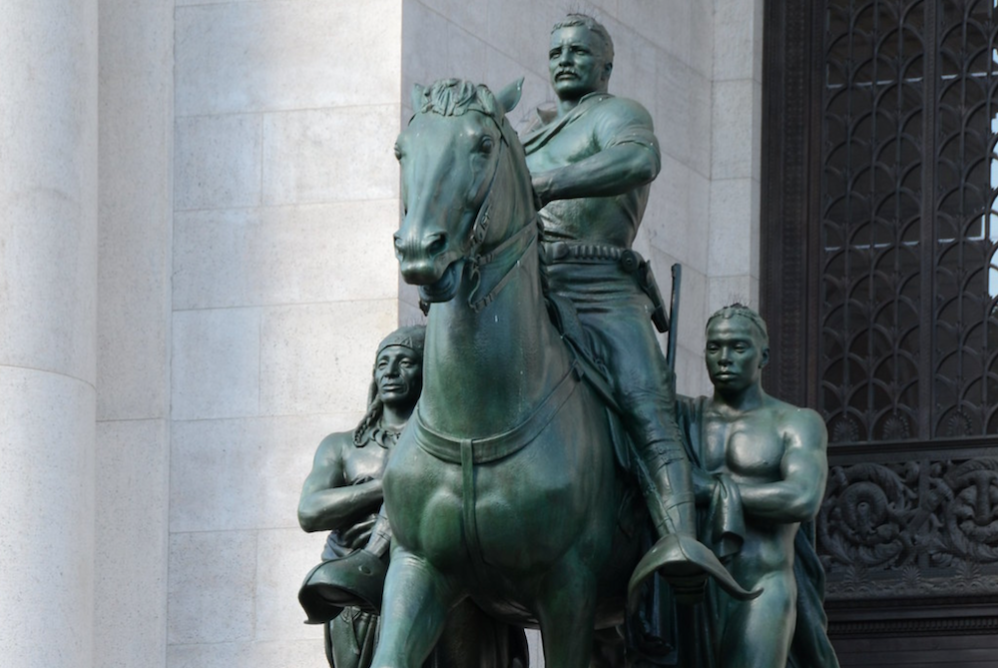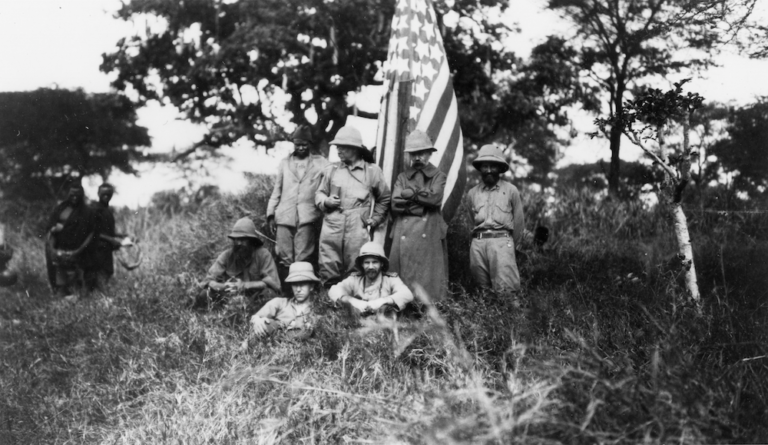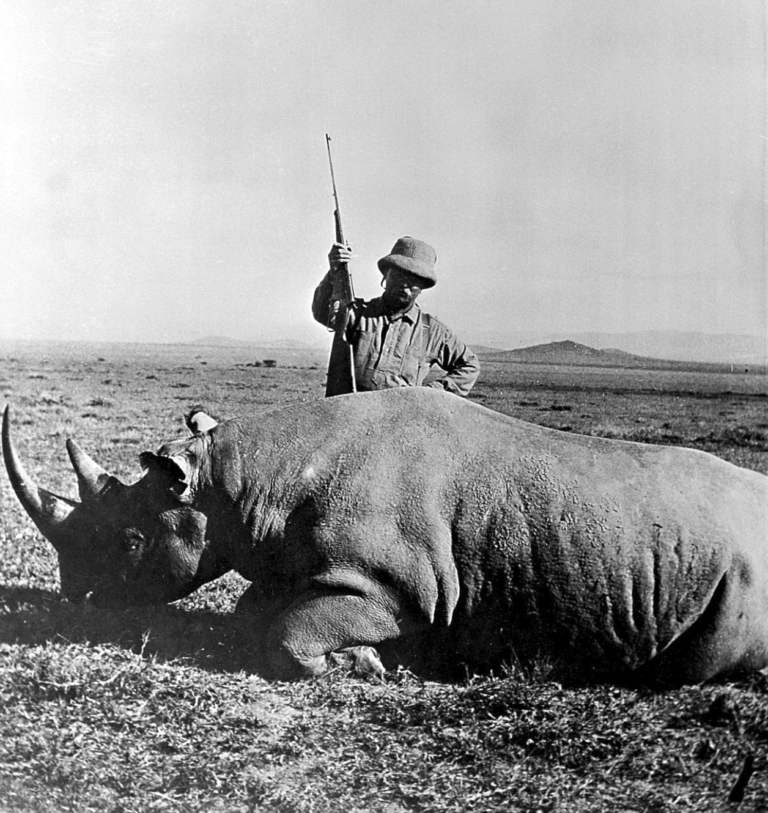
Posted on 06/24/2020 6:20:10 AM PDT by Kaslin

Since the museum has already explicitly stated Roosevelt had 'troubling views on race,' its condemnation is not merely of the monument, but of the man.
As the woke mob continues its crusade, pillaging cities and purging history, the next victim of the “tear it all down” impulse is Theodore Roosevelt, or at least a statue of him. But if Teddy is so problematic he must be canceled, mustn’t we also cleanse all the artifacts connected to his legacy, including thousands of animals?
The desecraters never intended to stop at Confederate monuments, of course, and now the sculpture honoring the 26th president of the United States, whom the museum described in its statue-assessment press release as having had “troubling views on race,” outside the American Museum of Natural History in New York City must come down.
The statue depicts Roosevelt mounted on a horse between two standing men, a Native American and an African, a trio which famed American architect John Russell Pope described as a “heroic group.” Even the sculptor himself, James Earle Fraser, noted, “The two figures at [Roosevelt’s] side are guides symbolizing the continents of Africa and America, and if you choose may stand for Roosevelt’s friendliness to all races.”
But the museum has requested the statue be removed, saying it “communicates a racial hierarchy that the Museum and members of the public have long found disturbing.” According to Mayor Bill de Blasio, it “explicitly depicts Black and Indigenous people as subjugated and racially inferior.”
To be sure, Roosevelt’s museum footprint extends far beyond a single statue in NYC. In fact, what Howard Zinn’s “A People’s History of the United States” may not have taught the cancel mob pushing for the removal of everything they find objectionable is that Roosevelt’s passion for nature and conservation boosted the educational inventory of American museums and provided an abundance of invaluable specimens. Roosevelt’s most notable naturalist contributions resulted from a trip he took to Africa at the conclusion of his presidency.
“I am not in the least a game butcher. I like to do a certain amount of hunting, but my real and main interest is the interest of a faunal naturalist,” Roosevelt wrote to the Smithsonian Institution’s administrator, Charles Doolittle Walcott, in 1908. “Now, it seems to me that this opens up the best chance for the National Museum to get a fine collection, not only of the big game beasts, but of the smaller animals and birds of Africa; and looking at it dispassionately, it seems to me that the chance ought not to be neglected.”
And get a fine collection he did. Roosevelt, his son, and a team of scientists embarked on an African hunting expedition, with the Roosevelts killing 296 and 216 animals, respectively, and the accompanying team of scientists harvesting thousands more. Roosevelt valued animal and land conservation, but he also recognized the importance of preserving the memory of disappearing species before civilization could wipe them all out — a principle sorely lost on those who seek to obliterate collective memories today.

Thanks to the expedition, the Smithsonian received not only valuable specimens from Africa, but those hunted by none other than the president of the United States. Roosevelt created a prioritized list of animals he hoped to acquire, including “lion, elephant, black rhinoceros, buffalo, giraffe, hippo, eland, sable, oryx, kudu, wildebeest, hartebeest, warthog, zebra, waterbuck, Grant’s gazelle, reedbuck, and topi.”
He set his sights on one creature in particular, the white rhinoceros, which was nearing extinction. However, the path to obtaining one was treacherous. To get to the Lado Enclave, where the species remained, Roosevelt had to trek through a hot spot of the sleeping-sickness epidemic, which had already claimed the lives of hundreds of thousands of people.
“On the one hand, Roosevelt’s instincts as a conservationist told him to refrain from shooting any white rhino specimens ‘until a careful inquiry has been made as to its numbers and exact distribution,’” Lunde wrote. “But on the other hand, as a pragmatic naturalist, he knew that the species was inevitably doomed and that it was important for him to collect specimens before it went extinct.”
Lunde noted if not for Roosevelt’s hunt, the Smithsonian likely wouldn’t have had another chance to acquire the white rhino species, which is presumed to be extinct in the wild, with only a few remaining in captivity today.

Teddy and his entourage obtained more than 23,000 specimens total, with the United States National Museum and National Zoological Park receiving at least 1,000 large mammal skins and 4,000 small, as well as approximately 5,000 plant specimens. The late Charles Handley, a well-known Smithsonian mammalogist, said the group’s contribution is “still the largest and most comprehensive single research collection of East African flora and fauna ever made.”
It took years to prepare the many animal mounts, some of which are still on display. They were sent to the Smithsonian’s National Museum — with many facsimile species shared widely with other museums — and to the African mammal hall in New York City’s American Museum of Natural History, where some progressives now seek the removal of Roosevelt’s “problematic” statue.
Unsurprisingly, not everyone at the time was thrilled with Roosevelt’s animal-killing. His response to his detractors then, however, seems incredibly prescient today: “I can be condemned only if the existence of the National Museum, the American Museum of Natural History, and all similar zoological institutions are to be condemned.”
For reasons unrelated to his hunt, today Roosevelt has officially been condemned. While some in favor of removing the monument might argue the statue, not the man himself, is problematic, we’ve witnessed the slippery slope of historical cancellations before: There is no limiting principle. Since the museum has already stated Roosevelt had “troubling views on race,” its condemnation is not merely of the monument, but of the man.
It’s only a matter of time before all the scientific contributions of the Roosevelt-Smithsonian expedition are canceled, too, and for what?
As with George Washington, Thomas Jefferson, a number of abolitionists, Confederate generals, and other historical figures reduced only to their sins and defaced, what is to stop the woke mob from desecrating the scientific contributions of one of America’s most notable conservationists and naturalists over a 60-year-old statue? Roosevelt will have risked his life, and thousands of animals will have died for naught.
Roosevelt may have foreshadowed the destruction of his own museum legacy. Condemning everything? The cancel mob will have no problem with that.
It’s ALL the symbols of the founding of our country that they hate, and are destroying. But it isn’t the symbols that count. They destroy symbols to prepare our minds for the destruction of what they really plan to destroy: the country conceived as a republic embodying liberty and individual rights.
Animals will not be next. Living PEOPLE will be next.
The mob will turn to murder.
Our job is to defeat them.
They are definitely dangerous and need to be put in straight jackets. The Insane asylums need to be opened again.
They will come after our National symbol, The Bald Eagle.
Excuse me, that's The Follicly-Challenged Eagle!
Can Trump can issue EO for any group receiving federal funds must stop all removal of US presidents immediately or else .
The Left swears that Lee Harvey Oswald was a patsy and possibly a CIA agent.
Here’s some anti-American letters he wrote to his own family that was among those sold in a collection at auction. His sentiment echoes those expressed by the Leftists at hate America rallies for the past 60 years:
All but one of the remaining letters in the archive were written during his years in the Soviet Union. These particular letters are most interesting because they show his progression from complete enthrallment to Communism and the Soviet Union to disillusionment and paranoia. In an antagonistic two page letter (5.5” x 8”, not laminated) to Robert, dated Nov. 8, 1959, he wrote of his passion for the Soviet Union and his hate for the United States:
“Well, What shall we talk about? The weather perhaps? Certainly you do not wish me to speak of my decision to remain in the Soviet Union and apply for citizenship here, since I’m afraid you would not be able to comprehend my reasons.”
“You really don’t know anything about me. Do you know for instance that I have waited to do this for well over a year, do you know that I [in parentheses he has written a small phrase in Russian] speak a fair amount of Russian which I have been studying for many months.”
“I have been told that I will not have to leave the Soviet Union if I do not care to. this then is my decision. I will not leave this country, the Soviet Union, under any conditions, I will never return to the United States which is a country I hate.
“Someday, perhaps soon, and then again perhaps in a few years, I will become a citizen of the Soviet Union. but it is a very legal process, in any event, I will not have to leave the Soviet Union and I will never leave.”
“I received your telegram and I was glad to hear from you, only one word bothered me, the word ‘mistake’. I assume you mean that I have made a ‘mistake’ it is not for you to tell me this, you cannot understand my reasons for this very serious action.”
“I will not speak to anyone from the United States over the telephone since it might be taped by the americans. . . .”
Two weeks later, he wrote again to Robert (8pp., 5.5” x 8”) on November 26, 1959, elaborating on his negative feelings about the U.S. government. Quoted in small part below:
“I shall begin by anserwing [sic] your question on why I and my fellow workers and communist’s would like to see the present capitalist government of the U.S. overthrown.”
“Do you remember the time you told me about the efforts of your milk company to form a union? Try to see why workers must from unions against their employers in the U.S.. It is because the government supports an economic system based upon credit which give rise to never ending cycle of depression , inflation, unlimited speculation (which is the phase America is in now) and war.”
“In this system art, culture, and the spirit of man are subjected to commercial enterprising, religion and education are used as a tool to suppress what would otherwise be a population questioning their government’s unfair economic system and plans for war.”
“Science is neglected unless it can be directly used in making war or producing more profit for the owners of business’s.”
“These are some of the reasons. look around you, and look at yourself. See the Segregation, see the unemployed and what automation is, remember how you were laided [sic] off at convair? I remember well the days we stood off-shore at Indonesia waiting to surpress [sic] yet another population, when they were having a revolution there in Mar. 1958. I can still see Japan and the Phillipines [sic] and their puppet governments. More important I can see the american in uniforms men who were there because they were drafted or because they were adventursom [sic] or unemployed in civilian life.”
“I will ask you a question Robert. What do you support the American government for? What is the Ideal you put forward? Do not say ‘freedom’ because freedom is a word used by all people through all of time.”
“Ask me and I will tell you I fight for communism. This word brings to your mind slaves or injustice, this is because of american propaganda, look this word up in the dictionary or better still, read the book which I first read when I was 15, ‘CAPiTAl’, which contains economic theorys [sic] and most important the ‘communist manifesto’. . . .”
“When I talked to a reporter I gave most of my reason’s, however the story I found out later was badly slanted and left out my real reason, the reporter was only interested in a colorful story. . . my Marx’ist [sic] learning brought me here to the Soviet Union. I have always considered this country to be my own. . . . These people are a good, warm alive people These people would never think of war, they wish to see all peoples live in peace but at the same time they wish to see the economically enslaved people of the west free. . .”
“I want you to understand what I say now, I do not say lightly, or unknowingly, since I have been in the military as you know, I know what war is like.
1. In the event of war I would kill any american who put on a uniform in defence of the american government - any American -.
2. That in my own mind I have no attachment’s of any kind in the U.S.
3. That I want to, and I shall, live a normal happy and peaceful life here in the Soviet Union for the rest of my life.
4. That my mother and you are (in spite of what the newspaper said) not objects of affection, but only examples of workers in the U.S.
. . . If you would give the contents of this letter (except for that which is for your benefit) to some reporter, it will clarify my situation. . . . Lee”
In the dusty African mammal hall at the museum, each mount is tagged by who donated it, who shot it, when, and where. The donator is often the shooter. There are many upper crust names shown there; Astor, Cabot, etc.
Disclaimer: Opinions posted on Free Republic are those of the individual posters and do not necessarily represent the opinion of Free Republic or its management. All materials posted herein are protected by copyright law and the exemption for fair use of copyrighted works.